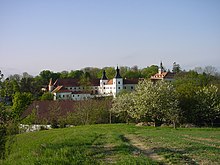Salaberg Castle
The Salaberg Castle rises in the southwest of the Lower Austrian town Hague . The architectural image of the palace is determined by three lined up courtyards, the silhouette of the building by the two towers of the middle courtyard and the clock tower of the arcade courtyard.
history
Founding time
The first known mention of the castle, which was still a castle at that time, can be found on a document from 1282. In 1530, the merchant Niclas Kölnbeck from Steyr bought the castle. The castle was expanded into a Renaissance castle by the Kölnbeck family . The arcade courtyard was built at this time. In 1618 the castle was sold to the family of the Counts Salburg , direct ancestors of the current owner Christian Freiherr von Mylius. Georg Siegmund Graf Salburg and his son Franz Ferdinand Graf Salburg, whose remarkable military career led to the position of Lieutenant General Field Marshal, were Salaberg's most important builders. They gave the castle the appearance it still shows today.
Extensions
Today's middle courtyard was built around 1640 by adding three two-storey tracts to the existing castle in the eastern part. This courtyard is flanked at the corners by two protruding towers that are almost square in plan. Around 1700, based on the construction of the palace chapel, the outer courtyard was built, which is essentially a farmyard. These palace extensions from the 17th and early 18th centuries are interesting from an art-historical point of view because, in contrast to the Renaissance part, not only the architecture but also the artistically valuable interior fittings and the gardens have been preserved.
The Venetian ballroom of the palace was also built under Franz Ferdinand Graf Salburg. The appearance of this ballroom is determined by the strong plastic stucco, the richly decorated paintings and the splendid marble work. These marble works, the Markus lion in the left center of the room, the portrait frieze in the area of the cornice area, the full-length paintings and the vivid ceiling frescoes fascinate every visitor.
Renovations
The times of war in the 20th century, but especially the military and civilian billeting caused by the occupation, left enormous damage to the buildings and works of art. Because of the unfavorable time, it was not until the 1970s that specific repair measures could be started. These were and will be continued by the current owner together with the Federal Monuments Office and the cultural department of the State of Lower Austria.
In 1999, after four years of renovation work, the bathhouse was completed with the help of the Messerschmitt Foundation and the Federal Monuments Office and has been open to the public since 2000 via the Hague Zoo. The Salaberg bathing facility deserves to be rated as a special rarity and can definitely be compared with the Badenburg in the park of the Nymphenburg Palace in Munich or with the marble bath in the Kassel Palace.
The castle itself is currently not open to the public. However, the Venetian ballroom can be rented for private events. The castle chapel, which has been restored since 1998, is also available for trade fairs (e.g. smaller wedding fairs).
Gardens
The gardens of the palace were mainly designed in the 16th and early 17th centuries, the baroque complex is still largely recognizable today, but was adapted several times until the 19th century. Nevertheless, it is one of the most important baroque gardens in Austria.
The large landscaped garden east of the palace was designed around 1870 by Eduard Petzold , director of the Prince Pückler Park in Bad Muskau, Silesia. In 1970–73 it was converted into the City of Haag Zoo . The facility is characterized by a particularly valuable historical tree population.
The gardens and parks are an important garden architectural monument and as such are explicitly under monument protection ( No. 19 in the appendix to § 1 Paragraph 12 DMSG ). The landscape garden in the zoo is open to the public (with admission), the palace gardens are only available to house guests.
literature
- Ernst Werner: City of Hague. Stadtbuch, self-published by the municipality of Haag, 1956 (out of print, book excerpts chapter Salaberg as Vogtburg and Salaberg in Baroque and Rococo , both chronik.stadthaag.com).
Web links
- Website of the castle (salaberg.at, salaberg.stadthaag.at)
- Entry about Salaberg Castle on Lower Austria Castles online - Institute for Reality Studies of the Middle Ages and Early Modern Times, University of Salzburg
- Entry via Salaberg to Burgen-Austria
Individual evidence
- ^ A b c Eva Berger: Historic Gardens of Austria: Gardens and parks from the Renaissance to around 1930 . tape 1 Lower Austria, Burgenland . Böhlau Verlag, Vienna 2002, ISBN 978-3-205-99305-6 , Salaberg, Schloßpark , p. 513 ff . ( limited preview in Google Book search).
- ↑ Géza Hajós; Matthias Cremer (Ill.): Historical gardens in Austria: forgotten total works of art. Austrian Society for Historical Gardens, Böhlau Verlag Vienna, 1993, ISBN 978-320598095-7 , Die Schloßgärten von Salaberg, p. 93 f ( limited preview in Google book search).
- ↑ Weblink Burgen-Austria
- ^ History. tierparkstadthaag.at, accessed November 22, 2015.
Coordinates: 48 ° 6 ′ 5 ″ N , 14 ° 33 ′ 28 ″ E




